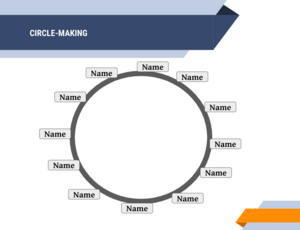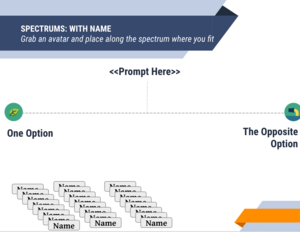Facilitation 101: Difference between revisions
| Line 118: | Line 118: | ||
| style="height: 74px; width: 46.8554%;" | | | style="height: 74px; width: 46.8554%;" | | ||
*Engage people early and often - set the tone in the first few minutes. | *Engage people early and often - set the tone in the first few minutes. | ||
* | *Start with names, pronouns and a check-in question. This is a great <span>chance to hear everyone’s voice on something that’s not a work topic. Depending on the group and the time available you might share personal things or keep it short and functional. (E.g. "I'm very tired, can we have a short break in the middle?") Examples of check-in questions include: what’s a song that represents you? What’s an object around you that says something about you? What’s one thing you’re proud of from last week? What’s something people might not know about you? What do you appreciate about another team member?</span> | ||
*<span>You might also try using the circle up tool (see image on the right). It helps people now who is in the room. It can be used for things like introductions.</span> | *<span>You might also try using the circle up tool (see image on the right). It helps people now who is in the room. It can be used for things like introductions.</span> | ||
*<span>Engage people throughout the meeting with prompts for discussion or raising new ideas.</span> | *<span>Engage people throughout the meeting with prompts for discussion or raising new ideas.</span> | ||
| Line 153: | Line 153: | ||
<p><span style="font-family: Montserrat, sans-serif;">'''Energizers provide a break/rest and can help increase engagement when included between the beginning to the end of a meeting/event <ref>https://trainings.350.org/resource/gamesenergizersdynamicas/</ref> :'''</span><span style="font-family: Montserrat, sans-serif;"> </span></p> | <p><span style="font-family: Montserrat, sans-serif;">'''Energizers provide a break/rest and can help increase engagement when included between the beginning to the end of a meeting/event <ref>https://trainings.350.org/resource/gamesenergizersdynamicas/</ref> :'''</span><span style="font-family: Montserrat, sans-serif;"> </span></p> | ||
{| class="wikitable" style="font-size: 14.4px; width: 100%; height: 364px; border-color: rgb(0, 0, 0);" | {| class="wikitable" style="font-size: 14.4px; width: 100%; height: 364px; border-color: rgb(0, 0, 0);" | ||
Revision as of 20:58, 8 August 2023
This page was created to provide tips and suggestions for activists related to facilitating meetings and events. This guide reflects several questions the HUB community has raised on facilitation.
The information included comes from existing organizer databases and resources and advice from movement thinkers. A special thanks to HUB advisor Amara Possain, who thoughtfully shared their expertise with the HUB team. Their knowledge is shared throughout. We encourage readers to share further ideas on how this page can be expanded upon and improved.
This guide includes... definers of good vs bad facilitation, tools for good facilitation, suggestions for increasing participant engagement and suggestions for managing group dynamics.
What do we mean by facilitation? [1] [2]
The role of a facilitator is to drive meeting or event participants towards clarity. Facilitation move things forward and build momentum. Facilitators also bring participants back to the purpose of the event/meeting. Remembering your purpose is key, so that when someone is taking up too much space, the facilitator can remind that you'd like to bring us back to the purpose and our goals. -Amara Possain, HUB advisor
In other words, the role of a facilitator and the purpose of facilitation is to: Source: adapted from Meeting Facilitation: The No-Magic Method (Berit Lakey) and Seeds for Change.
|
Take responsibility for helping the group stay on track and move through the agenda within the available time. |
|
Suggest how to move the group forward, rather than making decisions or plans for the group. |
|
Regulate the flow of discussion. |
|
Track decisions and milestones, providing clarity on the group's journey, clarifying and summarizing points. |
|
Prioritize the collective needs and goals of the group over individual within the group. |
Note: A person who has strong opinions or significant investment in the decisions being made may find it challenging to facilitate effectively. In some situations, it can be helpful to have an external facilitator.
What makes for poor facilitation?
The following reflections were raised by CAN-RAC and HUB team members in a joint workshop developed and delivered by Amara Possain:
- No agenda, no steering, lack of organization
- Repetition
- Lack of momentum
- Not stepping in to help pull out the positives (groups tend to focus on negatives)
- Not stepping in when some people are taking up too much space
- Not knowing the audience and how to tailor facilitation
- Not stepping in to get people back on track, when people hijack space
- Low engagement and energy, lack of initiative
- Not being able to move past certain items
- People weaponizing meeting rules and knowledge of process
- Passive aggressiveness
- Unclear roles in non-hierarchical structure
- Interrupting each other
- “Outfacilitating" the facilitator - often around an unbalanced power dynamic
- Miscommunications / inability to diagnose where we departed in understanding
Key facilitation skills [3]
- Active listening enables us to hear what others are saying;
- Questioning helps clarify what people are saying, or supports people to explore their needs and come up with new possibilities;
- Summarising helps remind us of the key points in the discussion and check we have the same understanding;
- Synthesising is the skill that allows us to draw together different views and ideas to form one proposal that works for everyone.
Good facilitation should result in good meetings with [4] :
- Clearly defined and mutually understood goals.
- A well-defined process for effectively achieving those goals.
- Recognition that participants bring their personal preoccupations and emotions alongside their interest in the subject matter.
- Fostering a sense of involvement and empowerment, allowing participants to feel ownership over the decisions and able to take necessary actions.
Tools for good facilitation
Stop and POP [5]
Source: adapted by Amara Possain (HUB advisor) from The P-O-P Model (Social Transformation Project, Leslie Sholl Jaffe & Randy Alford)
| Purpose |
Why? Why are we having this meeting? What is the purpose? |
|
Outcomes |
What do we want to accomplish as a result of this meeting? |
|
Process |
What steps will we take to achieve these outcomes and fulfill the purpose? |
Tools for increasing participant engagement
The following is a compilation of suggestions from Seeds for Change' [6] ', Amara Possain (HUB advisor and Daniel Hunter (350.org training director) [7] . Suggestions are relevant to virtual, in-person and hybrid meetings and events.
Energizers provide a break/rest and can help increase engagement when included between the beginning to the end of a meeting/event [8] :
|
Sam Went to Venus |
|
|
Something True About Yourself (from Gerald Gomani, Zimbabwe) |
|
|
Strategy Stretch (from Erika Thorne, USA) |
|
|
Why… Because… (from Gerald Gomani, Zimbabwe) |
|
Suggestions for managing group dynamics
From Amara Possain, HUB advisor and Meeting Facilitation: The No-Magic Method (Berit Lakey)
| Setting the tone |
|
|
Specific practices |
|
|
Handling specific situations |
|
If you have any suggested revisions or additional resources to share related to the above content, please email them to kenzie@lehub.ca.

- ↑ https://www.trainingforchange.org/training_tools/meeting-facilitation-the-no-magic-method/
- ↑ https://www.seedsforchange.org.uk/facilitationmeeting
- ↑ https://www.seedsforchange.org.uk/facilitationmeeting
- ↑ https://www.trainingforchange.org/training_tools/meeting-facilitation-the-no-magic-method/
- ↑ http://stproject.org/
- ↑ https://www.seedsforchange.org.uk/facilitationmeeting
- ↑ https://trainings.350.org/resource/online-monster-manual/
- ↑ https://trainings.350.org/resource/gamesenergizersdynamicas/

